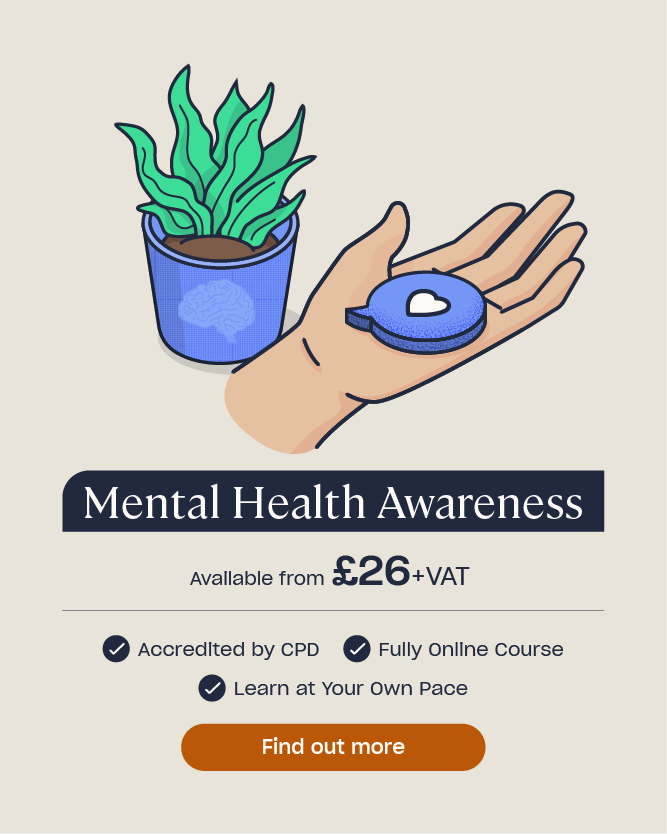How to Talk to Someone Who is Suicidal: Raising Awareness Through Myths and Facts
People think about suicide for a number of different reasons and there are many myths surrounding it. It is important to be able to recognise the risk factors of suicide and have an understanding of how to talk to someone in need as it could save somebody’s life. Everyone can make a difference to those who have reached the point of wanting to end their lives.
This article contains ways to raise awareness of suicide and examples of risk factors to recognise in someone that might be having suicidal feelings. It will debunk some myths and includes suicide facts as well as guidance on how to talk to someone who is suicidal.
Want to Learn More?
Our Mental Health Awareness course aims to increase your understanding of common mental health conditions, including how or when it might suffer, and what you can do about it.
How to Raise Suicide Awareness
Suicide awareness involves making a proactive effort to raise awareness around suicidal behaviours. It focuses on reducing social stigma by bringing attention to the prevalence of suicide and encouraging open discussion around it.
In 2020, 4912 people died by suicide in the United Kingdom, with males aged 45-49 continuing to have the highest suicide rate of any demographic.
- Mental health problems.
- Different types of abuse including domestic, sexual or physical.
- Bereavement.
- The end of a relationship or a break-up.
- Long-term illness.
- Financial problems.
- Isolation or loneliness.
- Homelessness.
- Being in prison.
- Addiction or substance abuse.
- Pregnancy, childbirth or postnatal depression.
- Side effects of medication.
Raising awareness of suicide can help prevention efforts in a multitude of ways. Discussing the risk factors or causes of suicide can aid people in recognising if someone is feeling suicidal, which in turn can help with early intervention and preventing that individual from ending their life.

Other benefits of raising awareness of suicide include:
- Helping overcome stigma.
- Helping to facilitate open and honest conversations.
- Equipping people with the ability to address the situation successfully.
How to Recognise the Risk Factors of Suicide
If someone you know is, or has, experienced any of the common causes mentioned, they may be at a higher risk of suicide. It is important to note that a prior suicide attempt is the single most important risk factor for suicide in the general population.
A few other risk factors that you might recognise in someone who is feeling suicidal include:
Being sad or moody – The person may have long-lasting sadness and mood swings or may have recently become down.
Sudden calmness – The person may suddenly become calm after a period of depression or sadness.
Withdrawing from others – The person may choose to be alone and avoid friends or social activities. They may also lose interest or pleasure in activities they previously enjoyed.
Changes in personality, appearance, sleep pattern – The person’s attitude or behaviour might change, for example suddenly becoming less concerned about their personal appearance, or sleeping much more or much less than typical for that person.
Showing dangerous or self-harmful behaviour – The person might engage in potentially dangerous behaviours such as driving recklessly, having unsafe sex or increasing their use of drugs and/or alcohol.
Experiencing recent trauma – This could include the death of a loved one or pet, divorce or break-up of a relationship, diagnosis of a major illness, loss of a job or serious financial problems.
Being in a state of deep despair – The person may talk about feeling hopeless, having no reason to live, being a burden to others, feeling trapped or being in severe emotional pain.
Making preparations – The person might begin to put their personal business in order. This could include visiting friends and family members, giving away personal possessions, making a will and cleaning up their room or home. Often the person will search online for ways to die, some will write a note before attempting suicide.
Threatening suicide or talking about wanting to die – Not everyone who is considering suicide will say so, and not everyone who threatens suicide will follow through with it. However, every threat of suicide should be taken seriously.

Due to the number of risk factors identified, it is important for individuals to know how they can raise suicide awareness. Familiarising yourself, and others, with the signs and symptoms can help you identify someone at risk. Sometimes a short conversation with someone can be enough to make a difference between life or death.
A useful way to remember how you can help someone in need is by following the WAIT acronym.
It stands for:
W – watch out for signs of distress and uncharacteristic behaviour such as social withdrawal.
A – ask about suicidal thoughts, this can help them express how they’re feeling.
I – it will pass with time; assure them that with help the feelings will pass.
T – talk to others; encourage them to speak about how they feel and maybe seek help from a GP or health professional.
Whilst it is important to raise awareness of suicide, it is also crucial that you are able to separate the myths from the facts.
Suicide Myths
Suicide is a very sensitive topic and is surrounded by stigma. There are also many myths that can have damaging effects.
Some of the most harmful suicide myths include:
- Talking about suicide or asking someone if they feel suicidal will encourage suicide attempts.
- Young people who talk about suicide never attempt suicide.
- A promise to keep a suicide note unopened or unread should be kept.
- Suicide attempts or deaths happen without warning.
- If a person attempts suicide and survives, they will never make a further attempt.
- Once a person is intent on suicide there is no way of stopping them.
- People who threaten suicide are just attention seeking.
- Suicide is hereditary.
- Only certain types of people become suicidal.
- Suicide is painless.

Although the above are myths, sometimes they are true in other ways so it is important to familiarise yourself with the facts too.
Suicide Facts
If you are ever in a situation where you need to help someone at risk of suicide, it is important you are aware of the facts and how you can help them. A lot of suicide facts are the direct opposite of the myths.
Some facts about suicide include:
- Talking about suicide provides the opportunity for communication.
- Talking about suicide could be a cry for help.
- A suicide attempt is an indicator of future attempts.
- Suicide can be prevented.
- Suicidal feelings are not genetically inherited.
- Everyone has the potential for feeling suicidal.
Statistics show that men are 3.1x more likely than females to commit suicide, with males aged 45-49 having the highest suicide rate overall. People in the United Kingdom aged 45-54 have the highest suicide rate of all ages. However, there are still around 200 young people that die by suicide every year.
No matter what the reason, age or gender – it is important to talk.
How to Talk to Someone Who is Suicidal
It can feel intrusive asking someone if they are having thoughts of suicide, but it could make a difference for someone in their most difficult day. There are many different approaches you can take, which will depend on if the person is a loved one, an acquaintance or a stranger. However, there is some general advice to follow which can help you have a potentially difficult conversation.
Know your resources
Create a safe space
Express Concern
Ask open ended questions
Show that you’re listening 
Don’t be afraid to bring up the topic
Use direct language
During the conversation, if the person directly discloses their suicidal feelings or plans they have made to end their life it can be very difficult to hear. You should try remaining composed and say thank you to them for sharing with you. Acknowledge that you are there for them and offer some hope that you can get them help.
You can also offer help with practical things they might need in the moment, such as getting them a glass of water or getting in touch with family or friends (with their permission). They might just want you to stay with them for a while, watching TV or doing an activity with them.
When they are able to think about their next steps, you can suggest making a ‘safety plan’ together. Safety plans lay out steps for coping in a crisis and ensure the person has the necessary support they need going forwards.

Safety plans include information on how to spot the signs that they might be nearing crisis, coping strategies to try, how they can use loved ones to distract from suicidal feelings, writing down which loved ones can help them and a list of helplines or mental health professionals to contact.
Offering a follow up with the person can be helpful to check in on how they are feeling. This doesn’t have to be explicitly called a ‘follow up’ and could be a text, phone call or meet up after the initial conversation. This could be an hour after or up to a couple of days after, especially if they are returning to work or school. Two common times that people begin to feel suicidal are if they are unhappy at work or unsettled at school.
Feeling Suicidal at Work
There is a strong link between suicide and occupation. ‘Low skilled’ male workers are three times more likely to take their own life than the national average. Other groups with an increased risk include nursing staff and primary teachers. These groups are also the most likely to experience workplace stress.
Employers have a legal duty to provide a safe working environment and must address any issues that could be leading to stress or suicidal thoughts. Therefore, knowing how to respond to an employee who is struggling with their mental health is an essential step towards the individual getting the help and support they need.
For more information on mental health awareness at work, take a look at our Mental Health Awareness for Managers training course.
Feeling Suicidal at School
The reasons behind suicide in teenagers and children are complex. In school, students are under a lot of pressure to fit in, excel in their studies and make important decisions about their future. There is often also added pressure at home and sometimes complications with friends or family. This can lead to teenagers and children feeling overwhelmed and sometimes having suicidal thoughts or feelings.

Access to support and resources is key to preventing suicide among students. Education around risk factors of suicide, where to get help or support and how to notice and respond if a peer is showing signs of suicidal feelings are crucial to address suicide within children and teenagers.
Raising awareness of suicide by starting the conversation and encouraging open discussion around it will, in turn, prevent the risk of suicide and could save a life.
Suicide is highly prevalent in society and can be a very sensitive topic to discuss. There is a lot of stigma and many myths surrounding it which can lead to misinformation. It is important to raise awareness of suicide through education of the risk factors and encouraging open discussion around it. Everyone can make a difference to those who have reached the point of wanting to end their lives, even by just having a conversation.
Further Resources:
- Mental Health Awareness Training
- Stress Awareness in the Workplace
- Mental Health Myths VS Facts
- How to Get a Job in Mental Health
- How to Talk About Mental Health











